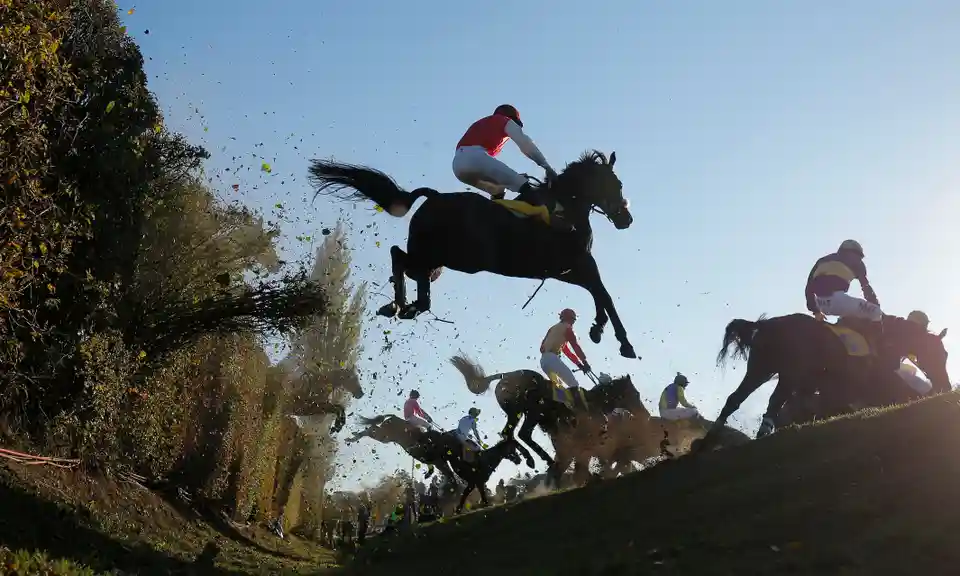History and Origins of Steeplechase Racing: Steeplechase Race

The steeplechase, a thrilling equestrian event, has a rich history spanning centuries, evolving from its humble beginnings to become a beloved sport worldwide. Its unique course, featuring obstacles like fences, water jumps, and ditches, presents a challenging test of both horse and rider, demanding exceptional athleticism and strategic planning.
Early Origins and Evolution
The origins of steeplechase racing can be traced back to 17th-century Ireland, where the term “steeplechase” emerged. The sport’s name derives from the practice of riding horses from one church steeple to another, a practice that served as a form of informal competition. These early races were often held over rough terrain, with participants navigating natural obstacles like fences and ditches. Over time, the sport evolved, with formal courses and standardized obstacles being introduced.
The First Formal Steeplechase Races
The first formal steeplechase race took place in 1830 at the Curragh, a racecourse in County Kildare, Ireland. The race, which covered a distance of four miles, featured a course with 16 obstacles, including fences, ditches, and a stream. This race, and subsequent ones, helped to establish the steeplechase as a distinct equestrian discipline.
Influence of Different Cultures and Countries
Steeplechase racing has spread across the globe, with different cultures and countries contributing to its evolution. In England, the sport gained popularity in the 19th century, and the Grand National, held annually at Aintree Racecourse, became a major event. France also embraced steeplechase racing, with the Grand Steeple-Chase de Paris, held at Auteuil Racecourse, becoming another prestigious event.
Famous Steeplechase Races and Their Significance
Throughout history, many famous steeplechase races have captured the imagination of spectators and participants alike. The Grand National, with its challenging course and thrilling finish, has become synonymous with steeplechase racing. The race’s history is filled with legendary horses and jockeys, including Red Rum, who won the race three times in the 1970s. The Grand Steeple-Chase de Paris, known for its demanding course and prestigious status, has also produced many notable winners, including the legendary horse, “L’Abbaye.”
The Steeplechase Course and Obstacles

Steeplechase courses are designed to challenge both horse and rider, offering a unique blend of speed, agility, and endurance. The course itself is a testament to the sport’s history, with obstacles that pay homage to the origins of the discipline.
Course Length and Terrain
Steeplechase courses are typically longer than flat races, ranging from two to four miles. This distance allows for a more diverse and challenging course, incorporating both open fields and wooded areas. The terrain can vary widely, with rolling hills, uneven ground, and even water features, demanding a high level of fitness and adaptability from both horse and rider. The terrain adds another layer of difficulty to the race, requiring riders to navigate changes in elevation and surface conditions.
Obstacles in Steeplechase Racing, Steeplechase race
Steeplechase races are known for their iconic obstacles, which are a defining feature of the sport. These obstacles are designed to test the horse’s jumping ability and the rider’s courage and skill.
Types of Obstacles
- Water Jumps: Water jumps are a crucial element of steeplechase courses, requiring horses to leap over a water-filled ditch. The water jump is often the most challenging obstacle, as horses need to judge the distance and approach the jump with confidence.
- Fences: Steeplechase fences are typically made of wood or brush and are designed to be challenging but not overly dangerous. The height and width of fences can vary, but they are always designed to test the horse’s jumping ability and the rider’s skill in controlling the horse’s jump.
- Ditches: Ditches are another common obstacle, often located before or after fences. Ditches are designed to test the horse’s agility and the rider’s ability to maintain momentum over uneven terrain.
Impact of Obstacles on Race Strategy and Tactics
The presence of obstacles has a significant impact on race strategy and tactics. Riders must carefully consider the placement of obstacles and the terrain surrounding them. For example, a rider might choose to approach a fence at a slower pace if the terrain leading up to the fence is uneven or if the fence is particularly high. Similarly, a rider might choose to conserve energy on flat sections of the course to have more strength to tackle the obstacles. The placement and design of obstacles can also influence the flow of the race, as riders try to position themselves strategically to avoid congestion and gain an advantage.
Steeplechase race – The steeplechase, with its water jumps and barriers, demands a unique blend of speed, endurance, and tactical prowess. One athlete who embodies this perfect storm is Soufiane El Bakkali , a Moroccan icon who has dominated the 3000m steeplechase.
His lightning-fast strides and unwavering focus make him a true spectacle, reminding us that the steeplechase is more than just a race; it’s a testament to human grit and athleticism.
The steeplechase, with its water jumps and barriers, demands a unique blend of speed and endurance. While most associate the event with long-distance runners, it’s fascinating to think about what a sprinter like wayde van niekerk could accomplish over the shorter steeplechase distances.
His explosive power and tactical brilliance might just revolutionize the event, adding a whole new dimension to the race.